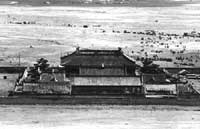|
|
||||
|
On the discovery
of the beautiful Mongolian Republic, |
||||
|
Amarbayasgalan Monastery reconstructed by Guru Deva Rinpoche, 1993 |
In the capital
Ulan Bator, visit Ganden Choeling and see the bronze Buddha of the
mythical sculptor Zanabazar Completely confined between China and Russia, the Republic of Mongolia - also called Outer Mongolia, to distinguish it from Inner Mongolia which is a part of China - broke free of the Soviet Union in the early nineties to become an independent nation. But, its peculiar geographical position and the scarse presence of industrial development, makes it completely dependent on neighbouring Russia for everyday necessities: from fuel to sugar, from school books to tyres... If your bus breaks down, it is not sure that the driver will find the necessary parts to fix it; and do not be surprised if the restaurant of your hotel serves exactly the same menu for three days running. You must also accept that although Mongolia has more cows than people, in the capital of Ulan Bator there is a shortage of milk and butter. The reason is simple: these commodities do not arrive in the city because there is not enough petrol for the lorries to transport them from the countryside. There are only a few shops, and it is not rare to see long queues of people trying to buy some particular newly arrived article which is destined to run out quickly. The land of Ghengis Khan, the national hero, is however an incredibly enchanting country, from both the environmental and spiritual points of view. The two million inhabitants are scattered over a land, geographically divided into two zones, five times vaster than Italy. To the north: hills and mountains covered in forests and seemingly endless pastures known as steppes, marked only by «yurtes», the circular tents of the nomads, and by a huge herds of beasts, from which the Mongols make cashmere, leather, milk, butter and delicious yogourt. The beauty of the steppes - crossed by the Mongols on horseback, with their proverbial ability to gallop like the wind - has inspired fascinating folk songs, which the nomads sing accompanied by the music of traditional instruments. To the south is the immense semi desert area, the mythical Gobi Desert, in which many people place the physical location of the pureland of Shambala, sought in vain by many travellers, but accessible only to those with stainless hearts. Here, one of the most ancient monasteries of Mongolia is to be found, Erdene Zu, encircled by 108 white stupas. The spiritual traditions of Mongolia, dating back to the fifteenth century, are exactly the same as those of the buddhists of Tibet. The intense religious life, animated until the beginning of this century by numerous monasteries, was suddenly broken around eighty years ago, due to the destruction carried out by Russian Communists in the most intense phase of revolution. Only a few temples survived. Only in the last decade, with their newly found independence, have the Mongols been able to rediscover with great joy their religious freedom. The remaining monasteries have been quickly repopulated and, with enthusiasm and incredible faith, they have started to restore and rebuild them: the builders sing while they work, amidst the piles of aromatic wood. To finance reconstruction work on the monasteries money is collected from the people reducing their already meagre salaries to practically zero (around ten dollars or less per month: the national currency, the Tugrik, is almost not worth the paper it is printed on). Sometimes, people simply place a «yurte» among the ruins of the monastery, where together with the monks they commence the day with prayers before going to work. The journey begins in Ulan Bator, the capital with old Russian style squares and monumental avenues. It is here that the splendid monastery of Ganden Choeling survived destruction, and where it is possible to admire the splendid sacred art of Mongolia, in particular the bronze Buddha statue of Zanabazar. The mythical sculptor who, in the seventeenth century, studied the techniques of sacred art in Tibetan monasteries and later interpreted them with extraordinary beauty. In Ulan Bator it is also possible to attend theatrical costumed performances, which also traditionally include a number of acrobats. If you cross the steppes and mountains, in the direction of the second major city of Mongolia, Darhan, there is a magical place which alone deserves a visit: after a journey along winding roads, the looming Amarbayasgalan Monastery appears, which was mysteriously saved from destruction. It is an enormous edifice with numerous pagoda style roofs, all encircled by rectangular walls. After almost 70 years of neglect, ambitious reconstruction work has been initiated under the guidance of the great eighty year old lama, Guru Deva. Here, it is possible to finally experience the real life of the Mongols, sleeping in beautifully painted «yurte», the monastery has prepared for visitors, and awakening in the morning to an unpolluted natural environment, to the sound of chanting monks. Enrica Mazzi
Departure from Moscow or Peking
|
|||
|
|
||||


